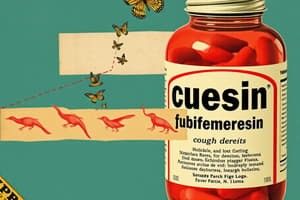Podcast
Questions and Answers
Decongestants like phenylephrine and pseudoephedrine alleviate congestion through which primary mechanism?
Decongestants like phenylephrine and pseudoephedrine alleviate congestion through which primary mechanism?
- Causing vasoconstriction of the respiratory tract mucosa. (correct)
- Increasing mucus production to clear the respiratory tract.
- Causing vasodilation in the respiratory tract mucosa.
- Blocking histamine receptors in the respiratory tract.
Which of the following is a common side effect associated with decongestants like pseudoephedrine and phenylephrine?
Which of the following is a common side effect associated with decongestants like pseudoephedrine and phenylephrine?
- Increased salivation
- Bradycardia
- Improved sleep quality
- Insomnia (correct)
What is the primary reason for the restrictions placed on the purchase of pseudoephedrine?
What is the primary reason for the restrictions placed on the purchase of pseudoephedrine?
- It interferes with the effectiveness of certain antibiotics.
- It can cause severe allergic reactions in some individuals.
- It has been shown to cause liver damage with prolonged use
- It is a key ingredient in the production of methamphetamines. (correct)
Why have decongestants containing phenylephrine increased in popularity compared to those containing pseudoephedrine?
Why have decongestants containing phenylephrine increased in popularity compared to those containing pseudoephedrine?
Diphenhydramine (Benadryl) belongs to which generation of antihistamines?
Diphenhydramine (Benadryl) belongs to which generation of antihistamines?
Loratadine (Claritin) and cetirizine (Zyrtec) are examples of:
Loratadine (Claritin) and cetirizine (Zyrtec) are examples of:
H1-receptor antagonist antihistamines are primarily used to treat symptoms related to:
H1-receptor antagonist antihistamines are primarily used to treat symptoms related to:
How do H1-receptor antagonist antihistamines work to alleviate allergy symptoms?
How do H1-receptor antagonist antihistamines work to alleviate allergy symptoms?
Which of the following is a common side effect associated with first-generation antihistamines, but less so with second-generation antihistamines?
Which of the following is a common side effect associated with first-generation antihistamines, but less so with second-generation antihistamines?
What is an important nursing consideration when administering antihistamines, especially in patients with allergies?
What is an important nursing consideration when administering antihistamines, especially in patients with allergies?
A patient with a persistent cough is prescribed guaifenesin. What physiological process is primarily responsible for this medication's therapeutic effect?
A patient with a persistent cough is prescribed guaifenesin. What physiological process is primarily responsible for this medication's therapeutic effect?
A patient with cystic fibrosis is prescribed acetylcysteine. In addition to its mucolytic properties, for which of the following conditions is acetylcysteine also indicated?
A patient with cystic fibrosis is prescribed acetylcysteine. In addition to its mucolytic properties, for which of the following conditions is acetylcysteine also indicated?
A patient with a history of asthma is prescribed acetylcysteine for thick mucus secretions. Which of the following potential side effects requires close monitoring in this patient population?
A patient with a history of asthma is prescribed acetylcysteine for thick mucus secretions. Which of the following potential side effects requires close monitoring in this patient population?
A patient is prescribed guaifenesin for a productive cough. What specific instruction should the nurse provide to the patient regarding medication administration to maximize its effectiveness?
A patient is prescribed guaifenesin for a productive cough. What specific instruction should the nurse provide to the patient regarding medication administration to maximize its effectiveness?
A patient reports experiencing nasal congestion due to allergic rhinitis. Which of the following medications would be most appropriate to alleviate this patient's symptoms?
A patient reports experiencing nasal congestion due to allergic rhinitis. Which of the following medications would be most appropriate to alleviate this patient's symptoms?
A patient prescribed acetylcysteine is concerned about the medication's unpleasant odor. What is the most appropriate response by the healthcare provider?
A patient prescribed acetylcysteine is concerned about the medication's unpleasant odor. What is the most appropriate response by the healthcare provider?
Both guaifenesin and acetylcysteine are used to manage respiratory conditions characterized by thick mucus secretions. However, their mechanisms of action differ. Which of the following statements accurately describes this difference?
Both guaifenesin and acetylcysteine are used to manage respiratory conditions characterized by thick mucus secretions. However, their mechanisms of action differ. Which of the following statements accurately describes this difference?
A patient taking pseudoephedrine for nasal congestion reports feeling jittery and having difficulty sleeping. What is the most appropriate initial nursing intervention?
A patient taking pseudoephedrine for nasal congestion reports feeling jittery and having difficulty sleeping. What is the most appropriate initial nursing intervention?
A patient with a persistent cough is prescribed guaifenesin. What is the scientific rationale behind advising the patient to drink plenty of fluids while taking this medication?
A patient with a persistent cough is prescribed guaifenesin. What is the scientific rationale behind advising the patient to drink plenty of fluids while taking this medication?
A patient with chronic bronchitis is prescribed acetylcysteine. What is the primary mechanism by which acetylcysteine improves the patient's respiratory function?
A patient with chronic bronchitis is prescribed acetylcysteine. What is the primary mechanism by which acetylcysteine improves the patient's respiratory function?
Why is acetylcysteine administered with caution to patients with asthma?
Why is acetylcysteine administered with caution to patients with asthma?
A patient is prescribed acetylcysteine for thick mucus secretions. Which information is most important to communicate to the patient?
A patient is prescribed acetylcysteine for thick mucus secretions. Which information is most important to communicate to the patient?
A patient with nasal congestion is considering using either pseudoephedrine or phenylephrine. What information is most important to consider when choosing between these medications?
A patient with nasal congestion is considering using either pseudoephedrine or phenylephrine. What information is most important to consider when choosing between these medications?
A patient with a known history of hypertension is seeking an over-the-counter decongestant. Which of the following medications would be the least appropriate for this patient?
A patient with a known history of hypertension is seeking an over-the-counter decongestant. Which of the following medications would be the least appropriate for this patient?
A patient with rhinitis is prescribed a decongestant. Which mechanism of action describes how decongestants alleviate nasal congestion?
A patient with rhinitis is prescribed a decongestant. Which mechanism of action describes how decongestants alleviate nasal congestion?
A patient taking guaifenesin reports experiencing dizziness. What is the most appropriate initial nursing intervention?
A patient taking guaifenesin reports experiencing dizziness. What is the most appropriate initial nursing intervention?
Why are individuals purchasing excessive amounts of pseudoephedrine likely to raise concerns among pharmacists and law enforcement?
Why are individuals purchasing excessive amounts of pseudoephedrine likely to raise concerns among pharmacists and law enforcement?
A patient taking an antihistamine reports experiencing significant drowsiness. Which of the following instructions is most important for the nurse to provide?
A patient taking an antihistamine reports experiencing significant drowsiness. Which of the following instructions is most important for the nurse to provide?
A patient with allergic rhinitis is prescribed an H1-receptor antagonist antihistamine. What is the expected primary outcome of this medication?
A patient with allergic rhinitis is prescribed an H1-receptor antagonist antihistamine. What is the expected primary outcome of this medication?
When explaining the difference between first-generation and second-generation antihistamines to a patient, which statement is most accurate?
When explaining the difference between first-generation and second-generation antihistamines to a patient, which statement is most accurate?
A patient reports using an over-the-counter decongestant for nasal congestion but is concerned about potential rebound congestion. Which of the following is the best recommendation?
A patient reports using an over-the-counter decongestant for nasal congestion but is concerned about potential rebound congestion. Which of the following is the best recommendation?
What is the rationale behind the placement of pseudoephedrine behind the pharmacy counter rather than on open shelves?
What is the rationale behind the placement of pseudoephedrine behind the pharmacy counter rather than on open shelves?
A patient taking a first-generation antihistamine complains of a dry mouth and constipation. These side effects are most likely due to which pharmacological action of the drug?
A patient taking a first-generation antihistamine complains of a dry mouth and constipation. These side effects are most likely due to which pharmacological action of the drug?
A patient with a known allergy is prescribed an antihistamine. What is the most important assessment the nurse should prioritize after administering the medication?
A patient with a known allergy is prescribed an antihistamine. What is the most important assessment the nurse should prioritize after administering the medication?
Which of the following best describes the mechanism of action of H1-receptor antagonist antihistamines in alleviating allergy symptoms?
Which of the following best describes the mechanism of action of H1-receptor antagonist antihistamines in alleviating allergy symptoms?
Why are decongestants like phenylephrine used to treat nasal congestion?
Why are decongestants like phenylephrine used to treat nasal congestion?
Flashcards
Guaifenesin
Guaifenesin
A medication used to treat cough from respiratory infections, available over-the-counter.
Expectorant
Expectorant
A type of medication, like guaifenesin, that increases hydration of mucus to make it easier to cough up.
Mucolytics
Mucolytics
Medications that break down thick mucus, like acetylcysteine, to make it less viscous.
Acetylcysteine
Acetylcysteine
Signup and view all the flashcards
Bronchospasm
Bronchospasm
Signup and view all the flashcards
Pseudoephedrine
Pseudoephedrine
Signup and view all the flashcards
Side effects of Guaifenesin
Side effects of Guaifenesin
Signup and view all the flashcards
Patient teaching for Acetylcysteine
Patient teaching for Acetylcysteine
Signup and view all the flashcards
Decongestants
Decongestants
Signup and view all the flashcards
Vasoconstriction
Vasoconstriction
Signup and view all the flashcards
Side effects of decongestants
Side effects of decongestants
Signup and view all the flashcards
First-generation antihistamines
First-generation antihistamines
Signup and view all the flashcards
Second-generation antihistamines
Second-generation antihistamines
Signup and view all the flashcards
H1-Receptor Antagonists
H1-Receptor Antagonists
Signup and view all the flashcards
Side effects of antihistamines
Side effects of antihistamines
Signup and view all the flashcards
Antihistamine uses
Antihistamine uses
Signup and view all the flashcards
Respiratory assessment in antihistamine use
Respiratory assessment in antihistamine use
Signup and view all the flashcards
Guaifenesin mode of action
Guaifenesin mode of action
Signup and view all the flashcards
Mucolytics vs Expectorants
Mucolytics vs Expectorants
Signup and view all the flashcards
Acetylcysteine indications
Acetylcysteine indications
Signup and view all the flashcards
Acetylcysteine side effects
Acetylcysteine side effects
Signup and view all the flashcards
Patient teaching for Guaifenesin
Patient teaching for Guaifenesin
Signup and view all the flashcards
Decongestant examples
Decongestant examples
Signup and view all the flashcards
Pseudoephedrine effects
Pseudoephedrine effects
Signup and view all the flashcards
Mucolytics general function
Mucolytics general function
Signup and view all the flashcards
Mode of action of decongestants
Mode of action of decongestants
Signup and view all the flashcards
Side effects of pseudoephedrine
Side effects of pseudoephedrine
Signup and view all the flashcards
Pseudoephedrine and meth connection
Pseudoephedrine and meth connection
Signup and view all the flashcards
Antihistamines for allergy symptoms
Antihistamines for allergy symptoms
Signup and view all the flashcards
H1-receptor antagonist action
H1-receptor antagonist action
Signup and view all the flashcards
Anticholinergic effects of antihistamines
Anticholinergic effects of antihistamines
Signup and view all the flashcards
Assessing respiratory status with antihistamines
Assessing respiratory status with antihistamines
Signup and view all the flashcards
Indications for antihistamines
Indications for antihistamines
Signup and view all the flashcards
Study Notes
Guaifenesin (Expectorant)
- Action: Increases mucus hydration, reducing viscosity for easier expulsion by pulling water into mucus secretions.
- Indications: Cough associated with respiratory infections.
- Side Effects: Minimal, but can include gastrointestinal upset and dizziness.
- Administration: Take with a full glass of water to maintain hydration. Water is critical as it's pulled into mucus secretions for thinning.
Acetylcysteine (Mucolytic)
- Action: Breaks down mucus molecules to thin secretions.
- Indications: Thick mucus disorders (cystic fibrosis, bronchitis), acetaminophen overdose.
- Side Effects: Bronchospasm (wheezing cough), nausea, vomiting, rash. Use cautiously in asthma patients.
- Patient Teaching: Medication smells like rotten eggs (normal).
Pseudoephedrine/Phenylephrine (Decongestants)
- Action: Causes vasoconstriction in respiratory tract mucosa, reducing swelling.
- Indications: Rhinitis (nasal congestion).
- Side Effects: Nervousness, palpitations, weakness, insomnia, potential rebound congestion.
- Pseudoephedrine Considerations: Controlled substance, requires pharmacist verification and driver's license presentation due to meth production risk. Phenylephrine decongestants are more readily available.
First and Second Generation Antihistamines
- Action: Block histamine receptors, preventing allergic reactions.
- Indications: Allergies (rhinitis, itchy/watery eyes, sneezing), motion sickness, urticaria (hives).
- First-Generation (e.g., Diphenhydramine): More sedative and anticholinergic effects (dry mouth, constipation, urinary retention, photosensitivity).
- Second-Generation (e.g., Loratadine, Cetirizine): Generally, less sedating than first-generation drugs.
- H1 receptor antagonists: Focus on H1 receptors in this respiratory section. H2 receptor antagonists are used for other purposes (e.g., heartburn).
- Nursing Considerations: Monitor respiratory status for patients with allergies due to anaphylaxis risk.
- Mechanism of Action (Histamine): Histamine is part of the body's immune response. It causes blood vessel expansion and skin swelling to protect the body.
Studying That Suits You
Use AI to generate personalized quizzes and flashcards to suit your learning preferences.
Description
Overview of expectorants like guaifenesin, mucolytics like acetylcysteine, and decongestants for respiratory conditions. Details actions, side effects, and administration. Includes patient teaching for acetylcysteine and considerations for pseudoephedrine.





